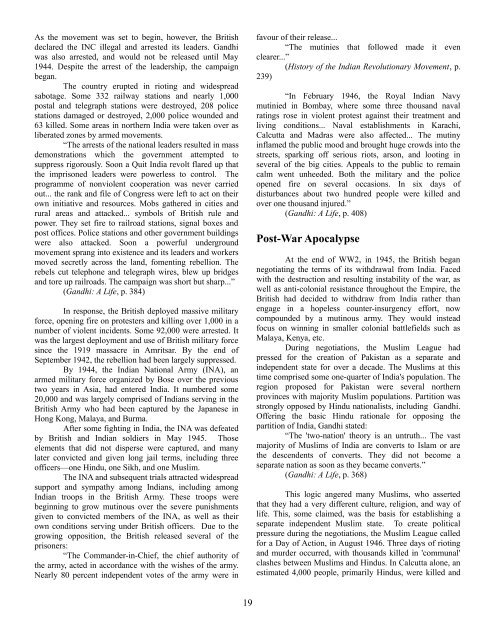smash-pacifism-zine
smash-pacifism-zine
smash-pacifism-zine
Create successful ePaper yourself
Turn your PDF publications into a flip-book with our unique Google optimized e-Paper software.
As the movement was set to begin, however, the British<br />
declared the INC illegal and arrested its leaders. Gandhi<br />
was also arrested, and would not be released until May<br />
1944. Despite the arrest of the leadership, the campaign<br />
began.<br />
The country erupted in rioting and widespread<br />
sabotage. Some 332 railway stations and nearly 1,000<br />
postal and telegraph stations were destroyed, 208 police<br />
stations damaged or destroyed, 2,000 police wounded and<br />
63 killed. Some areas in northern India were taken over as<br />
liberated zones by armed movements.<br />
“The arrests of the national leaders resulted in mass<br />
demonstrations which the government attempted to<br />
suppress rigorously. Soon a Quit India revolt flared up that<br />
the imprisoned leaders were powerless to control. The<br />
programme of nonviolent cooperation was never carried<br />
out... the rank and file of Congress were left to act on their<br />
own initiative and resources. Mobs gathered in cities and<br />
rural areas and attacked... symbols of British rule and<br />
power. They set fire to railroad stations, signal boxes and<br />
post offices. Police stations and other government buildings<br />
were also attacked. Soon a powerful underground<br />
movement sprang into existence and its leaders and workers<br />
moved secretly across the land, fomenting rebellion. The<br />
rebels cut telephone and telegraph wires, blew up bridges<br />
and tore up railroads. The campaign was short but sharp...”<br />
(Gandhi: A Life, p. 384)<br />
In response, the British deployed massive military<br />
force, opening fire on protesters and killing over 1,000 in a<br />
number of violent incidents. Some 92,000 were arrested. It<br />
was the largest deployment and use of British military force<br />
since the 1919 massacre in Amritsar. By the end of<br />
September 1942, the rebellion had been largely suppressed.<br />
By 1944, the Indian National Army (INA), an<br />
armed military force organized by Bose over the previous<br />
two years in Asia, had entered India. It numbered some<br />
20,000 and was largely comprised of Indians serving in the<br />
British Army who had been captured by the Japanese in<br />
Hong Kong, Malaya, and Burma.<br />
After some fighting in India, the INA was defeated<br />
by British and Indian soldiers in May 1945. Those<br />
elements that did not disperse were captured, and many<br />
later convicted and given long jail terms, including three<br />
officers—one Hindu, one Sikh, and one Muslim.<br />
The INA and subsequent trials attracted widespread<br />
support and sympathy among Indians, including among<br />
Indian troops in the British Army. These troops were<br />
beginning to grow mutinous over the severe punishments<br />
given to convicted members of the INA, as well as their<br />
own conditions serving under British officers. Due to the<br />
growing opposition, the British released several of the<br />
prisoners:<br />
“The Commander-in-Chief, the chief authority of<br />
the army, acted in accordance with the wishes of the army.<br />
Nearly 80 percent independent votes of the army were in<br />
favour of their release...<br />
“The mutinies that followed made it even<br />
clearer...”<br />
(History of the Indian Revolutionary Movement, p.<br />
239)<br />
“In February 1946, the Royal Indian Navy<br />
mutinied in Bombay, where some three thousand naval<br />
ratings rose in violent protest against their treatment and<br />
living conditions... Naval establishments in Karachi,<br />
Calcutta and Madras were also affected... The mutiny<br />
inflamed the public mood and brought huge crowds into the<br />
streets, sparking off serious riots, arson, and looting in<br />
several of the big cities. Appeals to the public to remain<br />
calm went unheeded. Both the military and the police<br />
opened fire on several occasions. In six days of<br />
disturbances about two hundred people were killed and<br />
over one thousand injured.”<br />
(Gandhi: A Life, p. 408)<br />
Post-War Apocalypse<br />
At the end of WW2, in 1945, the British began<br />
negotiating the terms of its withdrawal from India. Faced<br />
with the destruction and resulting instability of the war, as<br />
well as anti-colonial resistance throughout the Empire, the<br />
British had decided to withdraw from India rather than<br />
engage in a hopeless counter-insurgency effort, now<br />
compounded by a mutinous army. They would instead<br />
focus on winning in smaller colonial battlefields such as<br />
Malaya, Kenya, etc.<br />
During negotiations, the Muslim League had<br />
pressed for the creation of Pakistan as a separate and<br />
independent state for over a decade. The Muslims at this<br />
time comprised some one-quarter of India's population. The<br />
region proposed for Pakistan were several northern<br />
provinces with majority Muslim populations. Partition was<br />
strongly opposed by Hindu nationalists, including Gandhi.<br />
Offering the basic Hindu rationale for opposing the<br />
partition of India, Gandhi stated:<br />
“The 'two-nation' theory is an untruth... The vast<br />
majority of Muslims of India are converts to Islam or are<br />
the descendents of converts. They did not become a<br />
separate nation as soon as they became converts.”<br />
(Gandhi: A Life, p. 368)<br />
This logic angered many Muslims, who asserted<br />
that they had a very different culture, religion, and way of<br />
life. This, some claimed, was the basis for establishing a<br />
separate independent Muslim state. To create political<br />
pressure during the negotiations, the Muslim League called<br />
for a Day of Action, in August 1946. Three days of rioting<br />
and murder occurred, with thousands killed in 'communal'<br />
clashes between Muslims and Hindus. In Calcutta alone, an<br />
estimated 4,000 people, primarily Hindus, were killed and<br />
19



